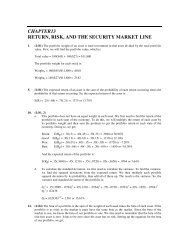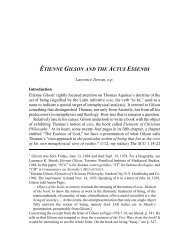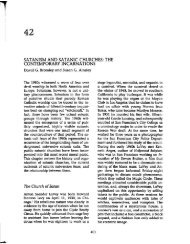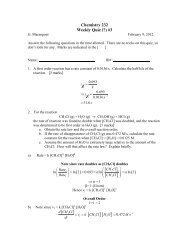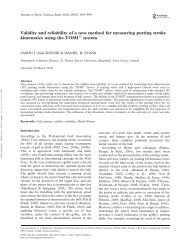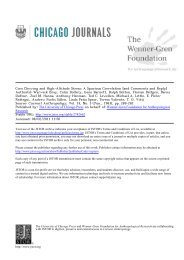Multiplier
Multiplier
Multiplier
Create successful ePaper yourself
Turn your PDF publications into a flip-book with our unique Google optimized e-Paper software.
Introduction to Economics, ECON 100:11 & 13<br />
<strong>Multiplier</strong> Model<br />
We will now rationalize the shape of the aggregate demand curve, based on the identity<br />
we have used previously, AE=C+I+G+(X-IM). We will in the process develop a more<br />
quantitative model of macroeconomics. Recall first the notion that expenditure on the<br />
aggregate in the economy, translates into production, which in turn translates into<br />
income.<br />
The main idea is that whatever you spend has to derive from earned income. So if we<br />
were to put this on a diagram, i.e. draw a relationship between real production and real<br />
income/output/GDP, it must be a 45 degree line extending out from the origin. I will refer<br />
to this curve as AE=Y.<br />
C,I,G,S,T.<br />
Aggregate<br />
Demand<br />
AE=Y, 45 o line<br />
Real<br />
Income<br />
Now we recall all the elements of AE individually, and graph them. First recall<br />
consumption by consumers in the economy is dependent on their disposable income.<br />
Second, investment, government, taxes, exports are autonomous, which means it is not<br />
dependent on the system, i.e. it is decided by something, someone. Let us write each<br />
relationship down.<br />
1. Consumption: C = a + bY D<br />
, where YD<br />
= Y − T . a is called the autonomous aspect<br />
or portion of consumption. Think of it as some level of subsistence consumption.<br />
b is called the marginal propensity to consume (MPC), and describes the<br />
proportion of disposable income an individual would consume. Note that Y is real<br />
income, and T is taxes. Then another way we can think about the consumption<br />
relationship with real income in the economy is that b is just the slope of the<br />
consumption function. The question is should it be steeper than the 45 degree line<br />
or gentler. Consider the following, if it is steeper, it would mean that the value of<br />
consumption is always greater than real income which is not possible. This then<br />
mean that it must be flatter than the 45 degree line, i.e. a slope of 1. Another way<br />
to think about it is that because we never spend every cent we have, since we<br />
save, the slope, or the marginal propensity to consume is always less than 1. Note<br />
1
Introduction to Economics, ECON 100:11 & 13<br />
<strong>Multiplier</strong> Model<br />
that another way to write the consumption equation in terms of Y and T is<br />
C = a + bY − bT . This means that the greater tax T, the lower the consumption<br />
line. a and b are both positive numbers/constants. Diagramatically,<br />
C,I,G,S,T.<br />
Aggregate<br />
Demand<br />
AE=Y, 45 o line<br />
C = a + bY D<br />
Real<br />
Income<br />
There is also in addition an interesting point. Note that what you do not consume,<br />
you save, which means 1- the marginal propensity to consume give you the<br />
marginal propensity to save.<br />
2. Investment, and Government spending are all autonomous. What this means is<br />
that it is a constant at every level of real income. Let the current level be I = I<br />
0<br />
and G = G 0<br />
for investment and government spending respectively.<br />
Diagrammatically, they are just horizontal lines as below.<br />
2
Introduction to Economics, ECON 100:11 & 13<br />
<strong>Multiplier</strong> Model<br />
C,I,G,S,T.<br />
Aggregate<br />
Demand<br />
AE=Y, 45 o line<br />
I = I 0<br />
G = G 0<br />
Real<br />
Income<br />
3. We lastly examine international trade. Recall that we think of exports as<br />
autonomous. Let the level of export, dependent on our trading partner’s national<br />
income be E = E 0<br />
. However, imports is dependent on our own national income.<br />
Although in our earlier discussion, we have not included an autonomous aspect of<br />
imports, but in general, due to specialization, there is an autonomous aspect to<br />
imports, since an economy cannot produce everything they need. Let the<br />
relationship that describes imports be IM = c + dY . This means that c can be<br />
thought of as autonomous imports, and d as the marginal propensity to import.<br />
Note that the equation says imports are dependent on real income. As in<br />
consumption, necessarily the diagrammatic representation of the line/relationship<br />
must be gentler than the 45 degree line. Note that c and d are both positive<br />
constants and d is a constant that is less than 1. Why? Note that the marginal<br />
propensity to consume (b) plus d cannot be greater than 1. That is because we<br />
know the economy saves, and given that, they cannot consume more than what<br />
they have.<br />
3
Introduction to Economics, ECON 100:11 & 13<br />
<strong>Multiplier</strong> Model<br />
C,I,G,S,T.<br />
Aggregate<br />
Demand<br />
AE=Y, 45 o line<br />
( c dY )<br />
X − IM = X − +<br />
Real<br />
Income<br />
4. Since we know that aggregate expenditure is the sum of all these above elements<br />
from point 1 to 3. To depict the relationship, all we need is to perform vertical<br />
summation. Why? First, let us sum autonomous G, and I to consumption C.<br />
C,I,G,S,T.<br />
Aggregate<br />
Demand<br />
AE=Y, 45 o line<br />
C + I 0<br />
+ G 0<br />
C + I 0<br />
C<br />
I = I 0<br />
G = G 0<br />
Real<br />
Income<br />
To include net exports, simply do the same. However, note that<br />
X − IM = X − ( c + dY ) is downward sloping with respect to real income, since as<br />
income rises the marginal propensity to import rises. This means that the slope of<br />
the AE line is gentler. What is the slope of the AE curve?<br />
4
Introduction to Economics, ECON 100:11 & 13<br />
<strong>Multiplier</strong> Model<br />
C,I,G,S,T.<br />
Aggregate<br />
Demand<br />
AE=Y, 45 o line<br />
C + I<br />
0<br />
+ G0<br />
+<br />
C + I 0<br />
+ G 0<br />
( X − IM )<br />
( c dY )<br />
X − IM = X − +<br />
Real<br />
Income<br />
What does the intersection mean? It is of course not possible that aggregate demand not<br />
equating with real income. This means that the point the economy spend, the AE is at the<br />
point at which it intersects with the 45 degree line. Each level of aggregate expenditure is<br />
dependent on the autonomous variables, and the price level. Then as price level rises,<br />
necessarily aggregate expenditure AE falls, while if price level falls, AE rises. How can<br />
we describe this algebraically? At the intersection, AE must equate with real income,<br />
which means:<br />
Y = C + I + G + X − IM<br />
⇒ Y<br />
⇒ Y + dY − bY<br />
⇒ Y<br />
⇒ Y<br />
⇒ Y<br />
= a + bY − bT<br />
( )<br />
a − c − bT0<br />
+ I<br />
0<br />
+ G<br />
=<br />
1+<br />
d − b<br />
1<br />
=<br />
1+<br />
d − b<br />
=<br />
0<br />
+ I<br />
0<br />
+ G<br />
= a − c − bT<br />
0<br />
{ a − c − bT + I + G + X }<br />
0<br />
0<br />
0<br />
+ X<br />
+ I<br />
0<br />
0<br />
+ X<br />
0<br />
0<br />
− c − dY<br />
+ G<br />
0<br />
0<br />
+ X<br />
( autonomous expenditure multiplier) × ( autonomous expenditure)<br />
What does this tell you?<br />
1. An increase(decrease) in autonomous variables, government spending (G),<br />
exports (X), investments (I) would lead to an increase(decrease) in aggregate<br />
expenditure and hence real income.<br />
2. The change in the autonomous variables does not lead to, in general, a $1 for $1<br />
change in real income, and consequently aggregate expenditure. Why? Consider<br />
1<br />
this, if b is greater than d, then 1 + d − b is less than 1, and greater than<br />
1+ d − b<br />
1. When that happens, a $1 increase(decrease) in any of the autonomous variables<br />
listed above (C,I,G) leads to a more than $1 increase(decrease) in aggregate<br />
0<br />
0<br />
5
Introduction to Economics, ECON 100:11 & 13<br />
<strong>Multiplier</strong> Model<br />
expenditure, and consequently real income. Note that a change in taxes change<br />
aggregate expenditure and hence real income in the opposite direction. This is<br />
what we learned earlier about multiplier effect, and this is the reason why we call<br />
this the multiplier model. What happens when d is greater then b (Consider<br />
an economy with little own production, and hence to rely on imports)? When<br />
would there be no multiplier effect; that is a $1 change lead to a $1 change?<br />
Deriving AD curve<br />
Now we can show how we can use the AE curve to derive the AD curve we learned<br />
earlier. First each AE is given a level of price. A change in prices alters the real income<br />
(the real value of money, and hence how much you can consume and import), however<br />
all the autonomous variables of AE remains unchanged. The diagrammatic relationship is<br />
below,<br />
6
Introduction to Economics, ECON 100:11 & 13<br />
<strong>Multiplier</strong> Model<br />
C,I,G,S,T.<br />
Aggregate<br />
Demand<br />
AE=Y, 45 o line<br />
AE(P 1 )<br />
AE(P 2 )<br />
AE(P 3 )<br />
Real<br />
Income<br />
/Real<br />
GDP<br />
Price<br />
Level<br />
P 3<br />
P 2<br />
P 1<br />
AD<br />
Real<br />
Output/<br />
Real<br />
GDP<br />
Since each AD is drawn given a level of autonomous expenditures, when those<br />
autonomous expenditures changes, we get a whole new set of AE lines, and consequently<br />
a new AD curve. This explains how AD can be shifted, and allows us to examine how<br />
government policy depending on the type of action shifts the AD and brings about a new<br />
equilibrium in the aggregate economy.<br />
7
Introduction to Economics, ECON 100:11 & 13<br />
<strong>Multiplier</strong> Model<br />
Limitations of the Model<br />
1. It is not a complete model of the economy. We say this because the model does<br />
not tell us how investments etc are determined within the economy. How do<br />
individuals in the economy really choose how much to consume, and how would<br />
they then react to changes made say by the firms. How do the agents in the<br />
economy determine their expectations?<br />
2. Price level will change in response to changes in AD, which in turn limits the<br />
magnitude of change in real output.<br />
3. Expectations make adjustment process more complicated (Rational Expectations<br />
Model, where agents in the economy are assumed to be rational and uses all<br />
information available to predict the expected equilibrium). What the AD/AS<br />
model and multiplier model does is to say that when the economy is in<br />
disequilibrium (equilibrium away from the long run equilibrium), it either<br />
recovers by itself, or the government does something to bring it back to potential<br />
equilibrium. Consider a negative AD shock that causes a recessionary gap, based<br />
on our argument, the economy either gets back by itself, or does so through direct<br />
spending or other policy. But what if the general outlook in the economy is a<br />
gloomy bearish one. Does government intervention change perception or<br />
expectation of the future? If not, all that will happen may be that the economy<br />
would keep experiencing lower and lower level of C and I, but keeps getting<br />
propped up by government spending with expectations unaltered.<br />
4. Shifts in expenditure may reflect desired shifts in supply and demand (structural<br />
changes) and not just changes by suppliers in response to changes in demand.<br />
Real Business Cycle Theory. What this means then is that by attempting to<br />
adjust the economy on the basis of perceived deviations from the potential output<br />
is incorrect, and disrupts the process of adjustment made within the economy.<br />
Consider a shift in consumption of fuel efficient means of transportation. The<br />
adjustment phase say from gasoline engine vehicles to say methanol vehicles may<br />
induce a huge jump in consumption, pushing the economy out of its potential<br />
output level. But it is simply induced by a real change technology which requires<br />
an adjustment period while everyone readjusts. If the government intervenes<br />
thinking the economy is over heating, say by raising interest rates, it may simply<br />
end up making the change that much tougher. That is the intervention is totally<br />
superfluous, because once all the changes runs itself out, the economy would get<br />
back to its potentially level. Real Business Cycle Theory highlights that<br />
fluctuations in the economy is a reflection of real changes in the economy (such<br />
as the technology change requiring adjustment time), so that it is a simultaneous<br />
change in demand and supply, and not just to reactions by supply from changing<br />
demand.<br />
Expenditures in the model thus far say that changes in current income, changes<br />
consumption. However, do individuals really do that, or do they base their consumption<br />
on lifetime income? Consider the following, when you choose to attend university, did<br />
you do you based on your current income or future lifetime income. In general, an<br />
individual’s consumption is partially based on what they foresee their income would be<br />
in long run, and current income. That is there is a portion of the individual’s income she<br />
is always willing to use regardless of his current income. Then changes to current income<br />
8
Introduction to Economics, ECON 100:11 & 13<br />
<strong>Multiplier</strong> Model<br />
will not affect her spending/consumption habits. But of course it is more common that if<br />
the deviation is quite substantial, such as a lottery winning, we would expect here to raise<br />
current consumption quite a bit immediately. This idea is know as the Permanent<br />
Income Hypothesis which says that expenditures are based on permanent of lifetime<br />
income, and not transitory changes in income. When this happens the MPC out of current<br />
income is zero, and the multiplier is 1, ignoring the effect out of importing.<br />
9


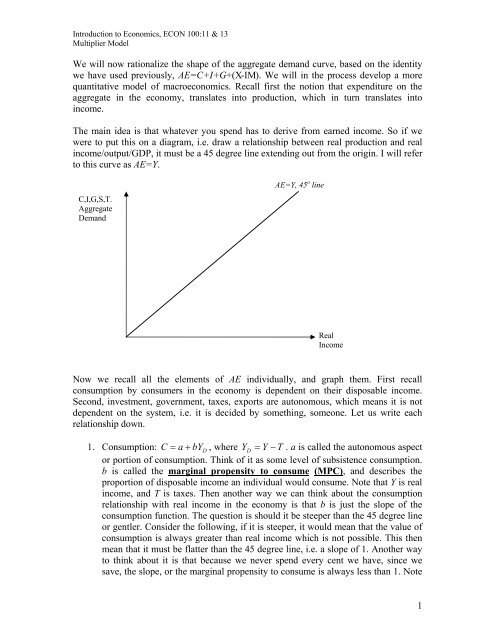
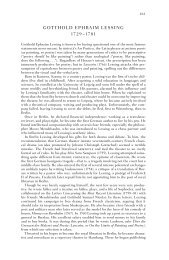
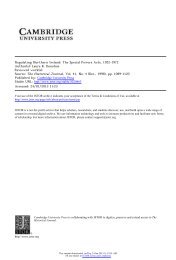

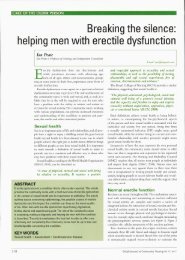
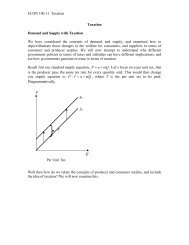
![The Rink - Cyril Dabydeen[1].pdf](https://img.yumpu.com/21946808/1/155x260/the-rink-cyril-dabydeen1pdf.jpg?quality=85)

